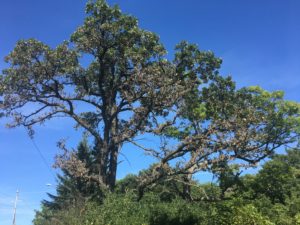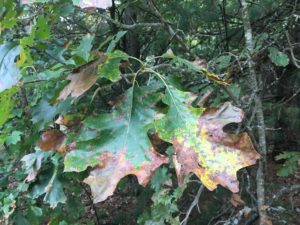By Mike Hillstrom, forest health specialist, Fitchburg, Michael.Hillstrom@wisconsin.gov, 608-513-7690
The most commonly reported forest health issue in recent weeks has been unhealthy looking oaks. Symptoms ranging from rapid mortality to gradual decline to superficial have been observed on all species of oak this summer.

White and bur oaks are being impacted by a variety of health issues in late summer 2019, including fungal leaf infections and bur oak blight. Symptoms are most severe in the lower half of this tree’s canopy. Credit: DNR Forest Health.
Here is a list of issues that were commonly affecting oaks in September:
- Oak wilt – Oak wilt is impacting red oaks and the occasional bur oak. Watch for bronze leaves on the ground with symptoms progressing from the top of the tree down.
- Bur oak blight – Bur oak blight symptoms are most common in the lower half of bur oak canopies. Wedge-shaped yellow and brown patches on the leaves and purple/black leaf veins are the most obvious symptoms of bur oak blight. Trees may decline over many years as the fungus that causes bur oak blight spreads through the canopy.
- Twig galls – Numerous bumps (galls) on the twigs of some white and bur oaks are caused by small wasps. Twig galls may cause some minor dieback of branch tips but are not considered a long-term health issue.
- Leaf galls – Oaks have many interesting leaf galls. Leaf galls are caused by tiny wasps and do not cause any damage to the tree.
- Oak twig pruner – The larvae of this longhorned beetle tunnels through oak twigs, ultimately causing them to break off the tree. A healthy tree will only incur minor damage and easily recover.
- Two-lined chestnut borer – TLCB is a wood-boring insect in the same group as emerald ash borer, except that it’s native. TLCB targets and kills stressed oaks over the course of several years. Stress factors currently affecting oaks that might also predispose them to TLCB attack include storm damage, flooding and old age.
- Leaf fungal pathogens – Anthracnose and Tubakia leaf spot fungi infect leaves and cause them to drop prematurely from the tree. Infections may reoccur yearly during wet periods but generally do not impact the long-term health of trees.
- Botryosphaeria – This fungal pathogen infects and kills branch tips. Health oaks typically recover from the damage within a year or two.
- Old bur and white oak decline and mortality – Forest health staff in Minnesota and Wisconsin are getting reports of decline and mortality in old (75+ years old) bur and white oaks. A decade of accumulated abiotic stresses such as drought and flooding has allowed TLCB and armillaria, a common root fungal disease, to infest and kill these trees.

Red oak leaf infected with a fungal leaf disease in late summer 2019. Credit: DNR Forest Health.
Oaks may be affected by one or more of these issues. For more information check out:
Management options vary for different oak issues so it is important to get a proper diagnosis. For help with oaks in forested settings, contact your local forest health specialist. Homeowners with unhealthy oak trees can submit samples to the UW Plant Disease Diagnostic Clinic for a fee or hire an arborist for a tree assessment.
